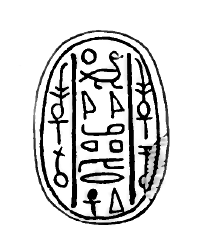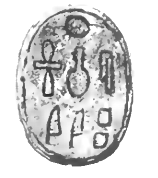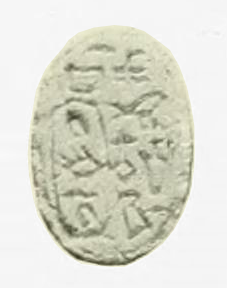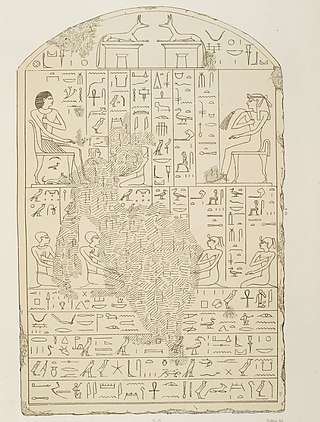Theories
Wife of Sheshi, Mother of Nehesy
Ryholt (1997) believe Tati played an official political role. Such seals are otherwise only known for kings, heirs apparent and royal treasurers of the Fourteenth Dynasty, and the use of the cartouche is attested otherwise mainly for kings. Tati's seals have been found at Leontopolis and Abydos. Since her scarabs are of two designs, this has allowed them to be dated to the reign of Sheshi, since the designs correspond to a change that took place during his reign, as evidenced by his hundreds of surviving seals. The most likely explanation for her prominence is that she was the wife of Sheshi.
The Egyptologist Kim Ryholt suggested that Tati's marriage was probably part of a dynastic alliance between Sheshi and the Kushite rulers of Kerma. This is suggested by the strong relations the Fourteenth Dynasty is known to have had with Kerma, as well as by the names of Tati and her presumed son. The name Tati is attested in earlier execration texts naming a Kushite queen (spouse of Awaw) as one of the enemies of the pharaoh. It is possible that this earlier Tati was an ancestor and namesake of the Egyptian queen. A royal lineage for Tati would also explain why she of all the consorts of the Fourteenth Dynasty was accorded such high status, since her marriage was one of equals, forming an alliance between kingdoms.
According to Ryholt, Tati's son by Sheshi was Nehesy (nḥsy), whose name means "the Nubian", referring to the region around Kerma. On this theory, Nehesy probably received his name from his mother. Since he is known to have been an old man at the time of his accession, it is likely that Tati had died by then. There are no references to her with the title of queen mother.
New finds
Ryholt's interpretation has been challenged by a newly found stela that places Nehesy at the end rather than the beginning of the Second Intermediate Period. According to the stela, he was the brother of the "king's sister", Tany, who was most likely of Theban origin, making it unlikely that his mother was Tati.

The Second Intermediate Period dates from 1700 to 1550 BC. It marks a period when ancient Egypt was divided into smaller dynasties for a second time, between the end of the Middle Kingdom and the start of the New Kingdom. The concept of a Second Intermediate Period generally includes the 13th through to the 17th dynasties, however there is no universal agreement in Egyptology about how to define the period.

Sobekneferu or Neferusobek was a pharaoh of ancient Egypt and the last ruler of the Twelfth Dynasty of the Middle Kingdom. She ascended to the throne following the death of Amenemhat IV, possibly her brother or husband, though their relationship is unproven. Instead, she asserted legitimacy through her father Amenemhat III. Her reign lasted 3 years, 10 months, and 24 days, according to the Turin King List.

Userkare Khendjer was a minor king of the early Thirteenth Dynasty of Egypt during the Middle Kingdom. Khendjer possibly reigned for four to five years, archaeological attestations show that he was on the throne for at least three or four years three months and five days. Khendjer had a small pyramid built for himself in Saqqara and it is therefore likely that his capital was in Memphis.

Meruserre Yaqub-Har was a pharaoh of Egypt during the 17th or 16th century BCE. As he reigned during Egypt's fragmented Second Intermediate Period, it is difficult to date his reign precisely, and even the dynasty to which he belonged is uncertain.

The Thirteenth Dynasty of ancient Egypt was a series of rulers from approximately 1803 BC until approximately 1649 BC, i.e. for 154 years. It is often classified as the final dynasty of the Middle Kingdom, but some historians instead group it in the Second Intermediate Period.

The Fourteenth Dynasty of Egypt was a series of rulers reigning during the Second Intermediate Period over the Nile Delta region of Egypt. It lasted between 75 and 155 years, depending on the scholar. The capital of the dynasty was probably Avaris. The 14th Dynasty existed concurrently with the 13th Dynasty based in Memphis. Some of the contested rulers of the 14th Dynasty are commonly identified by Egyptologists as being of Canaanite (Semitic) descent, owing to the distinct origins of the names of some of their kings and princes, like Ipqu, Yakbim, Qareh, or Yaqub-Har. Names in relation with Nubia are also recorded in two cases, king Nehesy and queen Tati. However, the dynasty rulers are not referred to as Hyksos in the Turin kings list.

Anat-her may have been the first ruler of the Sixteenth Dynasty of Egypt, reigning over some part of Lower Egypt during the Second Intermediate Period as a vassal of the Hyksos kings of the 15th Dynasty. This is contested however, with the Egyptologists Kim Ryholt and Darrel Baker believing that 'Anat-Har was a Canaanite chieftain contemporary with the powerful 12th Dynasty. Others such as Nicholas Geoffrey Lempriere Hammond contend that he was a prince of the 15th Dynasty. 'Anat-Har's name means "Anat is content" and refers to the Semitic goddess Anat, showing that he was of Canaanite descent.

Seneferankhre Pepi III may have been a pharaoh of the 16th Dynasty during the Second Intermediate Period. According to Wolfgang Helck he was the fifth pharaoh of the dynasty. Alternatively, according to Jürgen von Beckerath, he was the thirteenth pharaoh of the dynasty. Because his position in the 16th Dynasty is highly uncertain, it is not clear who were his predecessor and successor.
Kim Steven Bardrum Ryholt is a Danish Egyptologist. He is a professor of Egyptology at the University of Copenhagen and a specialist on Egyptian history and literature. He is director of the research center Canon and Identity Formation in the Earliest Literate Societies under the University of Copenhagen Programme of Excellence and director of The Papyrus Carlsberg Collection & Project.

Maaibre Sheshi was a ruler of areas of Egypt during the Second Intermediate Period. The dynasty, chronological position, duration and extent of his reign are uncertain and subject to ongoing debate. The difficulty of identification is mirrored by problems in determining events from the end of the Middle Kingdom to the arrival of the Hyksos in Egypt. Nonetheless, Sheshi is, in terms of the number of artifacts attributed to him, the best-attested king of the period spanning the end of the Middle Kingdom and the Second Intermediate period; roughly from c. 1800 BC until 1550 BC. Hundreds of scaraboid seals bearing his name have been found throughout the Levant, Egypt, Nubia, and as far away as Carthage, where some were still in use 1,500 years after his death.

Sekhemre Sewadjtawy Sobekhotep III was an Egyptian king of the mid Thirteenth Dynasty of Egypt who reigned three to four years.

Sehetepibre Sewesekhtawy was an Egyptian pharaoh of the 13th Dynasty during the early Second Intermediate Period, possibly the fifth or tenth king of the Dynasty.

Ineni was an ancient Egyptian queen who lived during the Thirteenth Dynasty .

Nehesy Aasehre (Nehesi) was a ruler of Lower Egypt during the fragmented Second Intermediate Period. He is placed by most scholars into the early 14th Dynasty, as either the second or the sixth pharaoh of this dynasty. As such he is considered to have reigned for a short time c. 1705 BC and would have ruled from Avaris over the eastern Nile Delta. Recent evidence makes it possible that a second person with this name, a son of a Hyksos king, lived at a slightly later time during the late 15th Dynasty c. 1580 BC. It is possible that most of the artefacts attributed to the king Nehesy mentioned in the Turin canon, in fact belong to this Hyksos prince.

Khahotepre Sobekhotep VI was an Egyptian king of the late 13th Dynasty during the Second Intermediate Period.

Wazad was an Egyptian pharaoh during the Second Intermediate Period. According to the Egyptologists Kim Ryholt and Darrell Baker, Wazad was a member of the 14th Dynasty of Egypt reigning c. 1700 BC. As a king of the 14th Dynasty, he would have reigned from Avaris over the eastern Nile Delta and possibly over the western Delta as well. The Memphis-based 13th Dynasty reigned over Middle and Upper Egypt at the same time. Alternatively, according to Jürgen von Beckerath and Wolfgang Helck, Wazad was a ruler of the 16th Dynasty and a vassal of the Hyksos 15th Dynasty. This view is debated in Egyptology, in particular because Ryholt and others have argued that the 16th Dynasty was an independent Theban kingdom rather than a vassal dynasty of the Hyksos.

Sekhaenre Yakbim or Yakbmu was a ruler during the Second Intermediate Period of Egypt. Although his dynastic and temporal collocation is disputed, Danish Egyptologist Kim Ryholt believes that he likely was the founder of the Levantine-blooded Fourteenth Dynasty, while in older literature he was mainly considered a member of the Sixteenth Dynasty.

'Apepi was a ruler of some part of Lower Egypt during the Second Intermediate Period c. 1650 BC. According to the egyptologists Kim Ryholt and Darrell Baker, 'Apepi was the fifty-first ruler of the 14th Dynasty. As such he would have ruled from Avaris over the eastern Nile Delta and possibly over the Western Delta as well. Alternatively, Jürgen von Beckerath sees 'Apepi as a member of the late 16th Dynasty and a vassal of the Hyksos rulers of the 15th Dynasty.

Sharek or Shalek could have been a poorly known ancient Egyptian pharaoh during the Second Intermediate Period of Egypt.

Hatshepsut was the name of one or several ancient Egyptian king's daughter(s) of the 13th Dynasty. There are three instances where a person named Hatshepsut is mentioned. It is not known if these items refer to the same or different individuals.


















